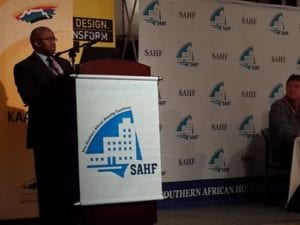While there has been good progress in South Africa to enable affordable housing opportunities for citizens, much work remains to ensure that affordable housing gets the prominence and focus it deserves. IMIESA speaks to Vuyi Hlabangane, managing Principle at GIBB, about the complexities of this market, touching on issues related to policy, planning, financial models and options for public and private sector housing.
The market in 2013 More than half of South Africa’s six million residential properties registered in the Deeds Office are worth less than R500 000. Currently, 3.5 million or 58% of these properties fall in the so-called affordable category – properties under R500 000, and indications are that 47% of these are in former townships. South Africa has a GDP in excess of US$467 billion (R4.67 trillion) and a population of over 51 million people. The affordable segment of the population is 88.14%. It is estimated that between 800 000 and 1.3 million households fall within the affordable housing segment, largely representing individuals or households earning less than R16 500 per month. Since 2004, an average of 70 000 new affordable units, including state-subsidised houses, have been registered at the Deeds Office per year, compared with 65 000 in the category of houses costing more than R500 000. Although fewer new houses in the aboveR500 000 market have been built since 2007, the figures have remained constant in the affordable housing market. The demand for affordable housing has drastically increased, resulting in a growing housing backlog and situations where demand for housing outstrips current supply. This is due to rapid urbanisation, and empowerment – both educationally and in terms of employment. The affordable housing market is seen as the fastest growing market in terms of volume and value, and indications are that more affordable homes worth less than R500 000 are being built each year than expensive houses. The Klarinet Housing Project In this interview, Hlabangane focuses on the Klarinet Housing Project in Mpumalanga to demonstrate a number of key principles involved in this market. “It is a well-known fact that South Africa has a housing and infrastructure shortage problem. Where there is property development, there is an issue with access to finance and infrastructure, says Hlabangane. “The Klarinet Housing Project, which is a National Priority Sustainable Integrated Affordable Housing development of over 12 400 units, has contributed towards providing much-needed homes for communities within the Emalahleni Municipality,” he states. However, it should be noted that the performance of the housing sector as a whole relies on a stronger working relationship and partnership between the public and private sectors. “Given the mounting challenges ahead, limited resources and the need to increase the rate of housing delivery, the industry must continue exploring and implementing mutually beneficial arrangements between the public and private sectors as seen in the planning and implementation of the Klarinet Housing Project,” he notes. Affordable housing applies to people earning between R3 500 and R16 500 per month. This is a wide margin and encapsulates a gap market as well. The figure is linked to inflation and includes worked and first time homeowners, often graduate professionals. “Empowerment as a whole tells a positive story within this market. Education and jobs have indeed had an impact and created a new segment. There is a housing backlog, making demand high, but there is also the issue of over-indebtedness and bad credit ratings that create a very high barrier to entry in this country. Almost half of this segment isaffected – largely incurred through unsecured credit,”continues Hlabangane. The debt challenge Hlabangane notes that personal financial literacy is a major challenge for the affordable housing market. For those with debt, rehabilitation is obviously the goal, but it is not that simple. Many rehabilitated consumers become recidivist, creating a negative situation all over again. Another problem in this market is the notion of the payment culture – being aware of rates and taxes, and in complexes, levies as well. “South Africa sees a very low approval rate on home loan applications. Debt to income level is high and the National Credit Act is very specific in terms of how banks should act in granting credit. Anyone buying a home for the first time should go through financial literacy training. This would include managing a budget and understanding the ancillary costs of home ownership.”The Klarinet Housing Project
“This project has a number of stakeholders, aside from the public. These include the developer (ABSA as implementing agent), provincial government as well as the local council,”says Hlabangane. “It also has a range of financial contributors, including government funding, some rental market and the open mortgage market. As a public private partnership (PPP), the municipality as well the province had some prior work, including conducting the public participation process. It is always an excellent contribution to a project when local government is able to take care of these matters prior to breaking new ground. Other assessments and interventions included an assessment of the market to see if there would be adequate uptake of the project.” Making the case In addition to the above assessments, further desktop studies can reveal the number of employers in the area, the salary ranges of the people living there already, as well as people who might be living there purely for work purposes, with no intention to buy. In this way, the types of housing and services supplied can be tailored to fit the budget. “This is not just a housing project, you must remember. It includes road, services, a clinic and a school. We are building an entire community, where people live, work and play. A very critical factor in developing the business of the project was the willingness of government to release the land to ABSA at a good price. This land needed to be suitably allocated with some services already reaching its border, and with the correct zoning parameters. This is where the local council play such a pivotal role during the PPP process. One really relies on the institutional and administrative knowledge of the local government to keep a process like this going. A clear risk is a change of council during the planning stage that may not see the value or understand the timelines of the project,” notes Hlabangane. This project had the input from provincial level from the get go, as well as the support of the municipal manager, along with sufficient technical skills in the municipality to see it along and advise the developers on certain issues. Hlabangane observes that in rural areas, this is not always feasible, which makes projects like this almost impossible in far-flung areas. Building a sustainable community “In this project, we were looking at the provision of a clinic,a schooland a business zone. This added to the sustainability of the project and its status as a mixed-use project,” continues Hlabangane. Another factor that was required from its partnership with local government was job creation. The Klarinet Housing Project is very large and was built over a six- or seven-year period, incorporatingmany people on the ground. Local contractors were utilised and, depending on their size and capacity, built anywhere from two to ten houses, under the supervision of the main contractor. A unique development bank ABSA is the only bank in South Africa that has its own development company. The bank owns half the land and government provided the rest. The ABSA Development Company invested in the provision of services and provided the development capital. Government did its part and enabled a positive business case by setting the cost of the land at an affordable level. Hlabangane explains: “This project was what is known as a BNG (breaking new ground) project. Most developments with a mix like this consist of really basic services. The cost of the land allowed us to provide an even quality of service and construction across the whole mix: those receiving houses through government subsidy, those renting and those who bought on the open market. There are some differences – notably in the size of the properties – but fundamentally, we felt it was important to develop the whole project with quality throughout. This is much a psychological factor as it is one of construction. Dignity is dignity, after all. In a typical RDP housing development, the quality of raids is poor, the electricity infrastructure is overhead and there are other marked differences. In an affordable housing project like this, everything is uniform. You won’t find any obvious differences between the housing types.” Conclusion The Klarinet Housing Project is a wonderful example of a successful PPP delivering housing to people across quite a wide socio-economic range. Projects like these are complicated to arrange, but there is assistance; in this case, large consulting groups like GIBB, and a well-equipped financial service provider, such as ABSA Bank.The will of the people – as represented by council – and national and provincial spheres of government make the success of such a venture highly likely. Home ownership is one of those critical economic factors that truly offer scope for intergenerational progress and empowerment, and ultimately lead to far more equity in a country so marked by disparities between poverty and wealth.







